It's A Zoo Life
Bobbie Jo Abrams, Our Wild Life
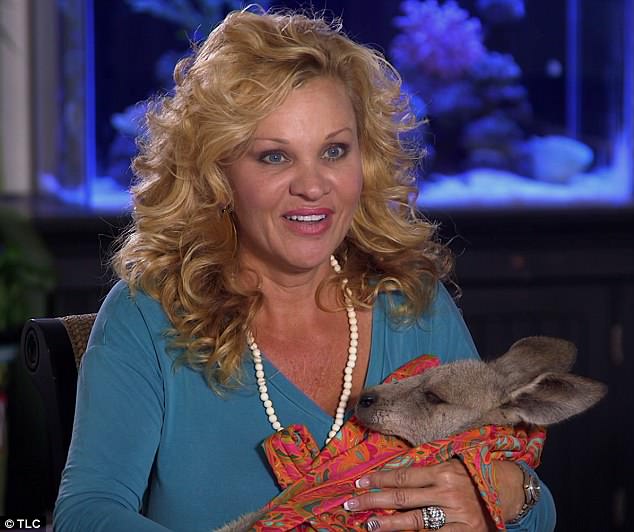 Bobbie Jo Abrams doesn't mind the camels in her kitchen or sloths in her living room. And she rather enjoys the kangaroos hanging onto her. Her new TLC hit series, Our Wild Life, is causing a lot of chatter about the 81 mostly exotic animals she shares her house with. She explains how she pays for her bizarre pet collecting habit.
Bobbie Jo Abrams doesn't mind the camels in her kitchen or sloths in her living room. And she rather enjoys the kangaroos hanging onto her. Her new TLC hit series, Our Wild Life, is causing a lot of chatter about the 81 mostly exotic animals she shares her house with. She explains how she pays for her bizarre pet collecting habit.
Bobbie Jo Abrams has a US FDA licensed and is regulated by her state where she has a little exotic zoo in her North Carolina backyard called, "It's A Zoo Life." The new TLC show, "Our Wild Life" follows the family and animals in six, one-hour episodes where you can expect a ton of wild moments.
While you might see the animals roaming inside the house, Bobbie Jo explains that it's only the babies that start out in the house for socializing. In fact, while she was speaking with us, she mentioned that she had her fifth marsupial on her, as she wears all of the baby kangaroos on her the first five or six months so she can bottle-feed them every four hours. This also makes them socialized, so when people come out visit with them, they're not stressed out. She explains that in their native country, kangaroos deal with snow. So as they get older, they're fine to be outside.
Some particular animals need a special climate and in North Carolina, Bobbie Jo explains that the weather's all over the place. They have four seasons and this is why all of the babies start out in the house with her. After the first year, they can them acclimate to the weather with heated houses.
Bobbie Jo says she gets her babies from all, all over. It depends on the situation. Some of them are rescues and some of them she's purchased from breeders.
What Bobbie Jo does is amazing, but what are family gatherings and the holidays like? She tells us that if she currently has a baby kangaroo on her, when people visit; she just hangs them on a chair or on a doorknob. It also depends on the weather on how they do things. Bobbie Jo tells us about a baby Lemur that started out in the house and had a really big cage. When she had guests over, he's put in the cage. When guests weren't in the house, he was able to roam free and fly around.
Living with all of these animals is a chosen lifestyle and Bobbie Jo explains that she keeps her house very clean. However, since television is over the top, people might think that there are really animals running around in the house all of the time, which is not true. Bobbie Jo explains that she always keeps things clean because she is regulated by the state and you never know when they're coming out to do an inspection, just like a health inspector would do at a restaurant. She's never had any problems and is in compliance with all the safety laws. Again, the only animals in the house are babies.
The whole concept of her zoo is encounters. In a regular zoo, you see the animals from a distance. However, when you come to her zoo, she likes to bring you in with the animals. But, for example the kangaroos, if their actual kangaroo mom raised them, you would never touch them because they would be too skittish. They would be afraid. But when you put that time and people come out and it's the whole "wow factor" where they get to be intimate with the animals.
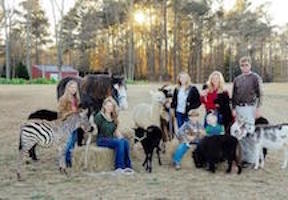 A tour of It's A Zoo Life takes about an hour and a half to meet everybody. But it's that one-on-one with the exotics and all the animals that people wouldn't normally get to touch.
A tour of It's A Zoo Life takes about an hour and a half to meet everybody. But it's that one-on-one with the exotics and all the animals that people wouldn't normally get to touch.
So instead of seeing them from a distance, you can actually rub the camel and the zebra. Some of her animals are ornery and the ones that are have a lot of safety rules about them. She explains to the children about boundaries and learning to respect boundaries. It's good to learn that early, because we have to have that code throughout our whole life.
Just think if someone kept touching your ears even though you asked them three times to quit touching your ears, by the fourth time they might get what was coming to them. So it's just a lot of common sense and a lot of love.
Bobbie Jo started her zoo in the last seven years because her husband does catering and amusements for big corporate picnics. In the meantime, very weekend Bobbie Jo and her daughters would do birthday parties and every time she made money she'd buy an animal.
When she got her USDA license, she was on the radar for some exotic that were rescues. That is how she got her camel and then a lot of things started popping up that way. Bobbie Jo tells us that all of her animals have a story just like we do. You find out how they are; you pair up best friends. If someone's being bullied, you move them. They want harmony just like we do. There's sometimes chemistry between the animals and you find out who loves each other. You also find out who's grumpy, because they're just like we are.
A lot of the animals are neutered, but there are some that Bobbie Jo breeds. Her African Crested Porcupines are breeding right now. But a lot of them are neutered to eliminate any kind of dominance. There are few that have babies and it's just how it's done at her zoo.
Even though people can get hands on with her animals, she also wants to let everyone know that she has a lot of safety precautions in place when people come out, with things like extra perimeter fences on the outside of the actual cages.
The good thing is that every person in the Abrams household has different interests and is on board with the zoo. However, one of Bobbie Jo's daughters, Kathy who is 18, loves the animals but she's not over the top with the animals like her little boy and her oldest daughter are, so Bobbie Jo doesn't push it on her. She lets her be her own person. Bobbie Jo explains that they do camps every summer and her daughter teaches the music. Bobbie Jo always tries to find out what everybody's good at, because everybody's good at something and she tries not to push them into something they don't like. When she did try and push it with her daughter, she didn't want her to feel like it was a job. So she let her daughter do her own thing. Plus, her daughter is really helpful and does a lot of cleaning. They are always so many other things to do, so if she doesn't want to do something specifically with the animals, there's always something else she can do. So like every other family, there are a lot of everyday needs, so she just tries to assess the needs and get through it. When everything is done, then everyone can have fun and do what they want to do.
 To run a zoo with all of these animals has to be expensive. Bobbie Jo tells us that in the very beginning when she first started, she would go to the dump and get old decks for the goats playgrounds. She would go to yard sales. She put ads out and bought old playhouses that kids no longer used. They live in a small town, so everyone knows her and would donate things.
To run a zoo with all of these animals has to be expensive. Bobbie Jo tells us that in the very beginning when she first started, she would go to the dump and get old decks for the goats playgrounds. She would go to yard sales. She put ads out and bought old playhouses that kids no longer used. They live in a small town, so everyone knows her and would donate things.
Bobbie Jo would then fix and paint all of the playhouses and made it the theme for her zoo. When people came out, they loved the way the animals lived.
While Bobbie Jo loves all of her animals, she says her favorite is the kangaroos. She said it's just because when you keep them on you for months, get up through the night and bottle-feed them, you get real attached. They even follow her everywhere she goes. Then there's her camel. He's getting really big, but when he first came to her, he was less than four foot tall, was 20 days old and weighed only 80 pounds. Bobbie Jo bottle-fed him and he's really, really loving and sweet too.
The camel was the one baby that wasn't raised in the house. He did come in the house as a baby just as a joke, because Bobbie Jo wanted a picture. Now he's tremendous and she calls him her dinosaur.
Visit website
Avoiding and Treating Heat Stroke in Dogs
Dr. Stacy Eckman, Fear Free
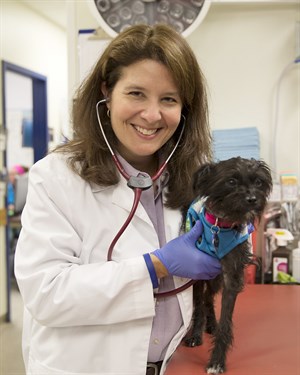 Typically, when you think of a dog getting heat stroke, you might envision a dog in a hot car. But heat stroke can affect your dog simply by being outside in 80-degree temperatures. Fear Free Vet Dr. Stacy Eckman talks about the breed of dogs most at risk and the myths behind improper treatment of heat stroke.
Typically, when you think of a dog getting heat stroke, you might envision a dog in a hot car. But heat stroke can affect your dog simply by being outside in 80-degree temperatures. Fear Free Vet Dr. Stacy Eckman talks about the breed of dogs most at risk and the myths behind improper treatment of heat stroke.
It's definitely that time of year when the weather starts heating up. This also means that our pets can start heating up and get heat stroke. Dr. Stacy Eckman, Clinical Assistant Professor and Chief Medical Officer at Small Animal Clinical Sciences, explains that there are many ways for our pets to get heat stroke.
While the most common way for our dogs to get heat stroke is from being left in a hot car, they can also get heat stroke from excessive heat and humidity if they are left outside. Environmental conditions can be a problem, especially if your dog hasn't really been acclimated to that type of weather.
There are also certain breeds of dogs that are more at risk. Dogs that have relatively short noses, or short muzzles, called brachycephalic dogs, are the dogs that are at the greatest risk. These include dogs like Pugs, Bulldogs, Shih Tzus and Boston Terriers, basically any dog with a short nose.
The first very first early signs of heat stroke that you'll see is that the animal is doing a lot of excessive panting. They act anxious. Sometimes people think that their pet is a little bit uncomfortable. You may see them kind of getting up and getting down and whining and pacing a little bit with excessive panting. They may even start to drool. Then signs and symptoms just kind of escalate from there. They will get a rapid heart rate and of course their temperature goes up. They can get really depressed as heat stroke progresses and end up with things like vomiting, diarrhea and shock, basically all of the kind of sequelae that goes along with it when it goes on for a prolonged period of time.
Keeping our pets inside in air-conditioning when it's really hot and humid outside is a great way to protect them from heat stroke, but there are other things you should do. You just need to be aware and recognize that it's hot and take steps to mitigate that.
Make sure that if it's getting to the hot part of the summer, or the hot part of the spring, that you give your pet time to acclimate to the weather. Maybe that's going to the park and spending shorter amounts of time out there playing, taking lots of breaks and making sure your pet has plenty of water and access to shade while they're there. All of these will help them acclimate and make sure that they don't get too hot too fast while they are doing so.
 Be careful of the breeds that will just go all day long in any sort of heat like Labradors and Border Collies. These are the sorts of dogs that just won't stop and take a break. So you really have to be mindful and make sure that they are taking adequate breaks and have adequate water and shade.
Be careful of the breeds that will just go all day long in any sort of heat like Labradors and Border Collies. These are the sorts of dogs that just won't stop and take a break. So you really have to be mindful and make sure that they are taking adequate breaks and have adequate water and shade.
There is no one size fits all and there is no certain temperature you should be worried about. For example, there are some dogs that live in Arizona in the desert and have acclimated to that weather with no problems. However, you may have seen dogs where you live where at even at 70 or 75 degrees, they actually struggle with it because they go out for prolonged periods of time and they're just not used to it. But still be aware for all dogs when out in anything over 80 degrees, as well as high humidity, which can also play a role in heat stroke.
If your dog is showing signs of heatstroke you need to get them to a veterinarian right away. There are things you can do in the meantime to help them, but the most common thing that people like to do, which is never recommended, is actually putting ice or ice water on them. You should never do this! Cool water is okay, but when you put the ice-cold water on an animal, it actually makes their blood vessels constrict down and that impacts how they're cooling. Ice or ice-cold water will actually keep heat internal. So cool water is great. If you have a fan and you can wet them down and then a blow a fan across them, this really helps. Also just providing them with shade and water will be extremely helpful.
Dogs don't actually have many sweat glands. They do have some sweat glands on their feet and maybe right around their nose, but they don't sweat and so their primary means of getting rid of heat is through panting. That's why you'll see them panting excessively. Dogs will even pant when it's cool outside if they're just running around, so it's the degree of that panting for that dog, which is a good sign that they're having trouble.
With a little awareness, you and your pet can enjoy the warm weather without any problems!
Visit Fear Free Happy Homes for tips on making your home fear free and to locate a Fear Free Veterinarian near you. Go to Fear Free Pets to become certified.
Listen and Explore the Fear Free Expert Series
A Rescue Cat Who Inspired a Community
Helen Brown, BONO
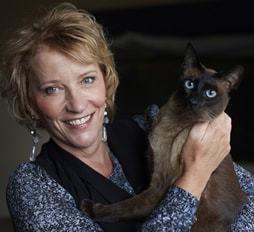 When life gives you lemons, you know what you're supposed to do! After battling cancer, Helen Brown embraced a "special needs" foster cat named Bono. This little cat was the last thing Helen wanted or needed, or so she thought. Helen tells us how Bono left his mark-on-her-heart.
When life gives you lemons, you know what you're supposed to do! After battling cancer, Helen Brown embraced a "special needs" foster cat named Bono. This little cat was the last thing Helen wanted or needed, or so she thought. Helen tells us how Bono left his mark-on-her-heart.
Helen Brown is a New Zealand born author and award winning columnist, best known for her memoirs about cats and the meaning of life. She now lives in Melbourne, Australia and was at a point in her life where she felt she was taking everything for granted. All of her children were grown and had left home and she wasn't sure what to do with the next phase of her life. So why not go to New York! She thought she would just go to New York and spend some time with her publishers and have a ball going to Broadway and doing whatever she felt like doing.
While that was her plan, her publishers had something else in mind for her. They said when she arrived; they wanted her to foster a rescue cat, which is the last thing she wanted. Helen then thought that if she was going to have a cat in New York, she would get a sleepy old tortoise shell, something she could just feed and still be able to go out shopping and have a great time.
Helen didn't want to foster cat because she was terrified she would fall in love. She had just survived breast cancer and was at a stage in her life where she was frightened of having more pain or loss in her life. She thought if she took on this cat and doesn't really know his background or how he would survive, he would only break her heart again. But that's the lesson of foster animals. They have such gratitude about them and there's so much to learn from them. She tells us they teach us to open our hearts and be open to love and allow ourselves to have that loss again to live more thoroughly.
 When Helen arrived in New York, she went to the local shelter to see what cat her publishes had in mind. When she got there, she said a cannonball shot past her. It was then that she was told his name was Bono and she would be taking him home.
When Helen arrived in New York, she went to the local shelter to see what cat her publishes had in mind. When she got there, she said a cannonball shot past her. It was then that she was told his name was Bono and she would be taking him home.
Bono was a victim of Hurricane Sandy and had been washed up on Long Island. Maybe it was his crazy hair or his amber eyes that looked like singer Bono's sunglasses that garnered his name.
The shelter was afraid Bono would never find a permanent home because he was in the advanced stages of kidney disease. As soon as people hear he has kidney disease, they don't want to adopt him even though he's got a beautiful personality. They wanted Helen to take him for a little while to give him a rest from the shelter and from the other animals. Just take him home for a short holiday and then bring him back. Helen took Bono to an apartment she rented, just for a break. However, within a few weeks she fell in love and couldn't bear the thought of him going back to the shelter to die.
Bono wasn't healthy enough to go home with her back to Australia. Plus Helen already had a very demanding Siamese cat called Jonah, who she felt very guilty about having left behind when she was in New York. In fact, she said he yelled at her through the phone whenever she called home, because he was very annoyed with her. She also has magpies, which she calls her pets. They'll come to her front door most mornings and they'll eat out of her hand. So those are the main animals in her life, but she thinks rescue animals have something special.
Helen started blogging on Huffington Post, trying to find Bono a home. If you want to find out what happened next with Helen and Bono, you will have to read her book, as she doesn't want to give any of it away!
Visit Website
Ticks Hitchhike on City Dogs Too - Dr. Debbie
 Ticks are common parasites known to infect people, pets and spread disease. Over 850 tick species exist worldwide, although fewer than a dozen species are of risk to pets in the U.S. But here in Las Vegas, pet owners often dismiss the existence of ticks with the likes of Bigfoot or the Loch Ness Monster. Think ticks are only a problem for pets that travel or visit the mountains? Think again.
Ticks are common parasites known to infect people, pets and spread disease. Over 850 tick species exist worldwide, although fewer than a dozen species are of risk to pets in the U.S. But here in Las Vegas, pet owners often dismiss the existence of ticks with the likes of Bigfoot or the Loch Ness Monster. Think ticks are only a problem for pets that travel or visit the mountains? Think again.
The Tick Tale
Ticks are parasites known to infect mammals, reptiles and birds and feed on their host's blood. Although of tiny size, ticks ingest 200 to 600 times their weight in a blood meal.
Ticks are attracted to a host's movement, body warmth or exhaled carbon dioxide and then latch on. Through this feeding behavior they can transmit diseases to pets such as Lyme disease, Rocky Mountain spotted fever, Ehrlichia, Babesia and Tularemia. Disease transmission takes some time and may occur after 36 to 48 hours of feeding behavior.
Some ticks can live months or up to a year off its host without a feeding, so year-round prevention is important for pets at risk for continued exposure.
Battling Ticks
There are many topical tick control products available for pets. Speak with your veterinarian for an product that is effective and safe with your pet's individual health in mind. Cats are sensitive to some ingredients, may develop toxicity, and should never be treated with a product labeled only for dogs. Additionally, pet owners using multiple products on their pet should first consult with their veterinarian to ensure safe use of combined products.
In addition to topical tick control, environmental treatment with foggers, sprays or pest control service should be considered for heavy infestations. Limit tick habitat zones by maintaining landscaping, avoiding overgrown grass and keeping shrubs and plants trimmed.
Pet Screening
Perform daily tick checks during tick season. Examine your pet for ticks in areas that the parasites hang out - around the head, behind ears, armpits and between toes.
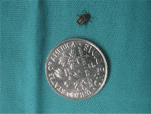 When removing a tick, avoid handling it directly. Wear gloves or handle with Kleenex since ticks can pass infections to people as well. Grasp the tick with tweezers close to the skin. Extract the tick by pulling straight out of skin. Don't squeeze, twist or leave any legs behind. Disinfect the area and dispose of ticks in rubbing alcohol.
When removing a tick, avoid handling it directly. Wear gloves or handle with Kleenex since ticks can pass infections to people as well. Grasp the tick with tweezers close to the skin. Extract the tick by pulling straight out of skin. Don't squeeze, twist or leave any legs behind. Disinfect the area and dispose of ticks in rubbing alcohol.
Here's a photo of a typical tick, born and bred in Las Vegas and recently extracted from one of my Shih Tzu patients named Kane. Kane never leaves the state, doesn't hike in the mountains, and enjoys the comforts of a house-dog lifestyle. A tick was discovered on Kane after a day of supervising his owner's yard work and shrub trimming.
Maybe Kane's story will be an eye-opener for city dwelling pet owners. Pet parasites like fleas, ticks and mosquitoes still lurk in that urban jungle.
Visit the Dogs & Ticks website for more information ticks, diseases and prevention.
Featured veterinarian known as "Dr. Debbie" on national pet radio program, Animal Radio. Ebook author of "Yorkshire Terriers: How to Be Your Dog's Best Friend"; "Pugs: How to Be Your Dog's Best Friend"; "Mini Schnauzers: How to Be Your Dog's Best Friend"; and "Shih Tzu: How to Be Your Dog's Best Friend." Dr. Debbie's books.
Visit Website
Animal Radio News - Lori Brooks
 The 5 Best Cities In The World For Cat Lovers
The 5 Best Cities In The World For Cat Lovers
If you're a cat lover you should know where the best cat cities are. At No. 5 is Tokyo, Japan, which is actually the current number one destination for cat lovers, and if you go a little farther outside the capital city you will find entire islands that are swarming with cats. At No. 4 is St. Petersburg, Russia, where more than 70 cats that live at the Hermitage Museum in St. Petersburg. At No. 3 is Houtong Cat Village, Taiwan, which is just outside of Taipei and started as a refuge for abandoned cats ten years ago. At No. 2 is Istanbul, Turkey where residents are especially kind, even reverent, towards their cat population. While strays in many countries can be in poor health, those on the streets of Istanbul tend to be well groomed and fed, thanks to the care of locals and shopkeepers. And the No. 1 city is Rome, Italy where the strays and outdoor cats of Rome are probably the best fed.
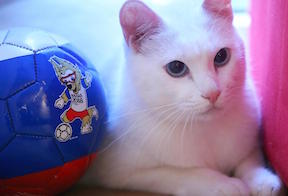 Prognosticating Cat
Prognosticating Cat
With the Soccer's World Cup currently taking place, you have to know there is, as always, a psychic animal making predictions about which teams will be the winners leading up to the championship game. One of the most famous prognosticating animals in history for the World Cup was in 2010 when Paul the Octopus predicted the winners of all of Germany's matches. This year, it's a beautiful white cat named Achilles who lives in Russia. Achilles lives in a museum in St. Petersburg's and will make his predictions by choosing between two bowls of food, each bowl bearing a team flag.
Hot Car Law
Lawmakers in Michigan have proposed a new law that would punish pet owners who leave their animals in hot or cold cars. Under the bill, anyone in the state caught could be fined or sentenced to jail. If the pet died, the new law would make the animal's death a felony. Twenty-eight states now have some form of a "hot car" law on the books for pets.
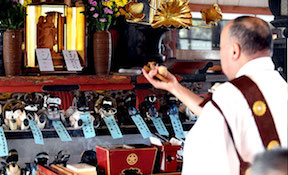 Robotic Dog Funerals
Robotic Dog Funerals
Most of us know how difficult it is losing a pet, but what happens when the "pet" in question is a robot? It's something that happens frequently in Japan where Aibo the robotic dog is manufactured. The demise of the irreparable Aibo robotic dog is marked in much the same way as that of humans, with a solemn ceremony at a Buddhist temple. At a recent memorial for more than a hundred "deceased" members of Sony's older generation of Aibo robot dogs, incense wafted through the air as priests in robes chanted and prayed for their souls. Each dog was wearing a tag that showed where they had come from and the name of their grieving owners. One 450-year-old temple near Tokyo has conducted services for 800 "dead" Aibo dogs. When Sony first put Aibo on the market in 1999, it sold out of the first batch of 3,000 in only 20 minutes, even though they were quite costly, at around $2,000 each. Before stopping production of the original Aibo, Sony had sold more than 150,000 of them and it's left many owners of broken robots truly heartbroken, while others are moving on with the new and improved Aibo. The new Aibo uses artificial intelligence and Internet connectivity to interact with its owner and surroundings. So, what is an owner of the older generation Aibo to do? Many have been sending them to a company that repairs vintage products and also holds memorial services for them. After the service, another company removes parts that can be used to fix less seriously damaged models, allowing some grieving people to get their old Aibo back.
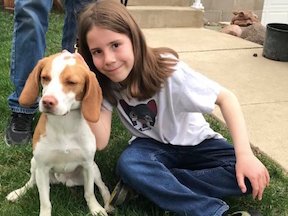 I've Pet That Dog
I've Pet That Dog
Gideon Kidd is a 9-year-old from Iowa whose love in life is petting dogs. This has all been documented with photos taken by his mother, which are then posted on his blog named "I've Pet That Dog!" So far, Gideon has documented himself petting over 300 dogs. HBO news program VICE noticed Gideon and called him the purest thing on the Internet. Gideon's Twitter page has exploded with more than 70,000 followers. Gideon's favorite breed of dog is the Chihuahua. At home, Gideon has 2 gerbils, 3 cats and a dog named Walter.
 Listen to the entire Podcast of this show (#967)
Listen to the entire Podcast of this show (#967)





